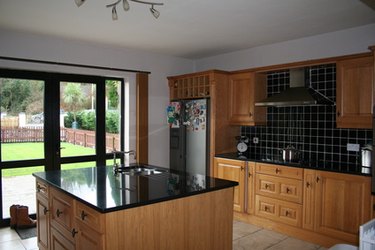
The kitchen backsplash is a decorative area that can be covered in tile, paint or wallpaper, or can be an extension of the countertop. Since the backsplash is a relatively small area of the kitchen design, you may wish to change the style or material to update the kitchen in a minimally invasive way. The first step to changing a kitchen backsplash is removing the old one. Whether the backsplash is tile or an extension of the counter, remove it as carefully as possible to prepare the surface for a fresh look.
Removing Backsplash Tile
Video of the Day
If the current kitchen backsplash is covered in tile of any kind, you can remove it by chiseling it away from its substrate. The key here is to do this as gently as possible. It's very easy to damage the wall behind the tiles, and since the wall typically extends behind the cabinets as well, you really don't want to have to replace it. Small holes, cracks or dents can be filled in with thin set; you want to make sure you don't rip out a big section. To remove old tile from the backsplash, you'll need a chisel, a hammer and a pry-bar. Start wherever the edge of the tiles is visible. This could be at the end of a tile run or at the top of the tile between a window and cabinet. Hold the chisel at the edge of the tile at a 45-degree angle and gently tap it with the hammer. You can always use more force if necessary, so start lightly to avoid wall damage. Once you've removed a few tiles, you can get the edge of the pry-bar under the next few tiles and pull them free. If you encounter a tile that seems seriously stuck, use the hammer and chisel.
Video of the Day
Removing the Countertop Backsplash
If you have a backsplash made of the same material as the counter, you may be able to remove it as well. The key is making sure that the backsplash is set on the counter and doesn't use part of the counter's top to make a cove. Check for a seam where the backsplash meets the counter. If the area is smooth and curved, the backsplash should stay put. If there is a seam, however, you can remove it. If the material is granite, marble or a quartz composite, use a hair dryer on high heat or a heat gun to melt the adhesive. Then use a putty knife to cut the old backsplash away. If this is a laminate counter, check for screws holding it in place. Unscrew them and use the putty knife to cut away any adhesive. A solvent will clean up the rest of the adhesive so you can install tile straight down to the countertop.